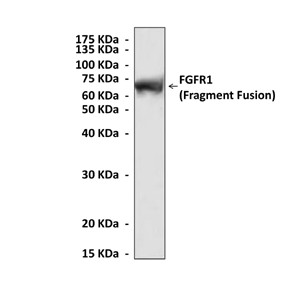Anti-FGF-R1: Mouse Fibroblast Growth Factor Receptor 1 Antibody |
 |
BACKGROUND Fibroblast growth factors (FGFs) and their receptors constitute an elaborate signaling system that participates in many developmental and repair processes of virtually all mammalian tissues. Among the 23 FGF members, ten have been identified in the brain. Four FGF receptor tyrosine kinases (FGFR1-4) are known so far.1 Ligand binding of these receptors greatly depends on the presence of heparan sulfate proteoglycans, which act as low affinity FGFRs. Ligand binding specificity of FGFRs depends on the third extracellular Ig-like domain, which is subject to alternative splicing. The FGF elicits the regulatory activity by binding to FGF receptor (FGFR)-heparin sulfate complexes and inducing receptor autophosphorylation, as well as phosphorylation of downstream signaling molecules. These include phosphorylation of Src and PLC-gamma, leading finally to activation of PKC, Crk and Shc.
SNT/FRS2 serves as an alternative link between FGFRs to the activation of PKC, and additionally activates the Ras signaling cascade.2 Deregulation of FGFR signaling, by activating mutations or ligand/receptor overexpression, could allow these receptors to become constitutively active, leading to cancer development. These cancers include hematopoietic and solid tumors (breast, bladder, and prostate carcinomas).
FGFR1, also known as basic fibroblast growth factor receptor 1, fms-related tyrosine kinase-2 / Pfeiffer syndrome, and CD331, is a receptor tyrosine kinase whose ligands are specific members of the FGF family. FGFR1 has been shown to be associated with Pfeiffer syndrome.3
Recently, a novel gene regulatory mechanism, integrative nuclear FGFR1 signaling (INFS), has been shown to control cell development.4 Activation of cell surface receptors (neurotransmitter, hormonal, or growth factor), and their intracellular messengers (i.e., cAMP), stimulates the release of FGFR1 from pre-Golgi membranes into the cytosol. The receptor and its ligand, FGF-2, are cotransported into the nucleus, by a mechanism involving importin, and engage in the regulation of genes at different chromosomal loci. The INFS signaling mechanism includes FGFR1 feeding forward these signals to CREB-binding protein (CBP), a common and essential transcriptional coactivator that acts as a gene activation gating factor. Nuclear FGFR1 executes the release of CBP from its inactive complex with RSK, a process shown to up-regulate gene activities associated with cell differentiation.5
REFERENCES
1. Zhang Y et al.: Molecular Endocrinology 22:167-175, 2008.
2. Acevedo VD et al.: Cell Cycle 8:580-588, 2008.
3. Itoh N et al.: Biochem. Biophys. Res. Commun. 169:680–5, 1990.
4. Stachowiak MK et al.: DNA Cell Biol 26, 811–826, 2007.
5. Dunham-Ems SM et al.: Mol. Biol. Cell 20: 2401-2412, 2009.
2. Acevedo VD et al.: Cell Cycle 8:580-588, 2008.
3. Itoh N et al.: Biochem. Biophys. Res. Commun. 169:680–5, 1990.
4. Stachowiak MK et al.: DNA Cell Biol 26, 811–826, 2007.
5. Dunham-Ems SM et al.: Mol. Biol. Cell 20: 2401-2412, 2009.
Products are for research use only. They are not intended for human, animal, or diagnostic applications.
Параметры
Cat.No.: | CP10102 |
Antigen: | Purified recombinant Fc-fusion protein, containing the human FGFR1 ECM domain, expressed in HEK293 cells |
Isotype: | Mouse IgG2b |
Species & predicted species cross- reactivity ( ): | Human, Mouse, Rat |
Applications & Suggested starting dilutions:* | WB 1:1000 IP 1:50 IHC (Paraffin) 1:100 ICC n/d FACS n/d |
Predicted Molecular Weight of protein: | 145 kDa (mature form), 120 kDa (immature form) |
Specificity/Sensitivity: | Detects FGFR1 proteins expressed in human cells. |
Storage: | Store at -20°C, 4°C for frequent use. Avoid repeated freeze-thaw cycles. |
*Optimal working dilutions must be determined by end user.
Документы
Информация представлена исключительно в ознакомительных целях и ни при каких условиях не является публичной офертой








